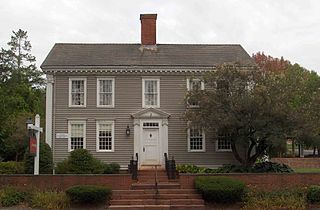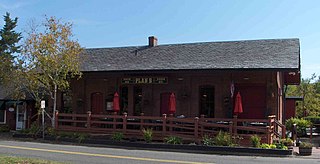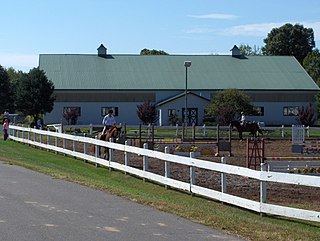
Simsbury is a town in Hartford County, Connecticut, United States. The population was 23,511 at the 2010 census. The town was incorporated as Connecticut's 21st town in May 1670.

The Captain Elisha Phelps House is a historic house museum at 800 Hopmeadow Street in Simsbury, Connecticut. The colonial-era house was built by David Phelps in 1711. His son Elisha Phelps received the land from his father and expanded the house in 1771. Elisha Phelps along with his brother Noah Phelps and others took part in the capture of Fort Ticonderoga in 1775. Capt. Phelps was appointed as commissary of the Northern Department by the Continental Congress.

The Amos Eno House, also known as the Simsbury 1820 House, is a historic home at 731 Hopmeadow Street in Simsbury, Connecticut.

The Danielson Main Street Historic District encompasses the historic late 19th-century commercial business district of the borough of Danielson in the town of Killingly, Connecticut. It extends along Main Street, between the Five Mile River and Spring Street, including a few buildings on adjacent side streets, representing the area's growth as a commercial and civic center in the late 19th and early 20th centuries. It was listed on the National Register of Historic Places in 1992.

The Simsbury Center Historic District is a 75-acre (30 ha) historic district located in the town center area of Simsbury, Connecticut. It encompasses seven blocks of Hopmeadow Street, as well as the cluster of commercial, civic, and residential buildings along Railroad, Station, and Wilcox Streets, and Phelps Lane. Although its oldest element is the cemetery, most of its buildings were built in the late 19th and early 20th century. It was listed on the National Register of Historic Places in 1996.

Knowlton Memorial Hall, also known as Ashford Town Hall, is located at 5 Town Hall Road in Ashford, Connecticut. It was built in 1924 to house town offices and the public library. Construction was made possible by a gift from Charles Knowlton, whose family had lived in the area since the 18th century. When built, it featured a number of modern innovations, including electrical service, and steam heat. In addition to town offices and the library, the building also has an auditorium which is used for town meetings. The building was listed on the National Register of Historic Places in 1994.

The Greenwich Avenue Historic District is a historic district representing the commercial and civic historical development of the downtown area of the town of Greenwich, Connecticut. The district was listed on the National Register of Historic Places on August 31, 1989. Included in the district is the Greenwich Municipal Center Historic District, which was listed on the National Register the year before for the classical revival style municipal buildings in the core of Downtown. Most of the commercial buildings in the district fall into three broad styles, reflecting the period in which they were built: Italianate, Georgian Revival, and Commercial style. The district is linear and runs north–south along the entire length of Greenwich Avenue, the main thoroughfare of Downtown Greenwich, between U.S. Route 1 and the New Haven Line railroad tracks.

Simsbury station is a former railroad station in the center of Simsbury, Connecticut. Built in 1875, it is a distinctive example of a railroad station with Italianate styling. The building was listed on the National Register of Historic Places on March 26, 1976 as Simsbury Railroad Depot. Presently, it houses a restaurant, called "Plan B".

The Horace Belden School and Central Grammar School are a pair of architecturally distinguished Late Gothic Revival occupying a single campus at 933 Hopmeadow Street and 29 Massaco Street in Simsbury, Connecticut. The Belden School was built in 1907 as the first Simsbury High School, and now serves as Simsbury Town Hall. The Central Grammar School, built in 1913, is now called the Central School. The buildings were listed as a pair on the National Register of Historic Places in 1993 for their architecture and their role in the town's educational system.

The East Weatogue Historic District is a 490-acre (200 ha) historic district in the town of Simsbury, Connecticut that was listed on the National Register of Historic Places in 1990. It then included 102 contributing buildings, 10 contributing sites, 11 contributing structures, and one other contributing object. The district encompasses a largely agrarian rural village centered at the junction of Hartford Road and East Weatogue Street, whose early development dates to the late 17th century, with the oldest surviving buildings dating to 1730. Most of the properties in the district are Colonial, Federal, or Greek Revival in character, with only a few later Victorian houses. In the early 20th century Colonial Revival houses sympathetic to the earlier buildings.

The Robert and Julia Darling House, now the Cannon Building, is a historic house at 728 Hopmeadow Street in Simsbury, Connecticut. Built in 1927 for a local business leader, it is one of the town's largest and most distinctive examples of Colonial Revival architecture. The house was listed on the National Register of Historic Places in 1991. It now houses professional offices.

Smith & Bassette was an architectural firm based in Hartford, Connecticut. Its partners included H. Hilliard Smith and Roy D. Bassette. It was active from 1911 to 1946.

The Simsbury Bank and Trust Company Building, also known as the former Town Hall Building, is a historic commercial and civic building at 760 Hopmeadow Street in Simsbury, Connecticut. Built in 1917, it is a prominent local example of Colonial Revival architecture with Beaux Arts features. It originally housed the town's first bank, and was its town hall between 1969 and 1984. The building was listed on the National Register of Historic Places in 1986.

The Simsbury Townhouse is a historic municipal building at 695 Hopmeadow Street in Simsbury, Connecticut. Built in 1839, it was Simsbury's town hall until 1931, and is a good local example of Greek Revival architecture. It was listed on the National Register of Historic Places in 1993. It continues to serve as a community resource.

The Ezekiel Phelps House is a historic house at 38 Holcomb Street in East Granby, Connecticut. Built in 1744, it is a fine example of Georgian architecture, associated with a prominent local family. It was listed on the National Register of Historic Places in 1982.

Amos Richards Eno was an American real estate investor and capitalist in New York City. He built the Fifth Avenue Hotel and many other developments on the streets of Broadway and Fifth Avenue, where he established a prominent family fortune of 20 to 40 million U.S dollars.

The Winchester Memorial Church, also known as the New Hampshire Conservatory of Music and the Arts, is a historic civic building in the center of Winchester, New Hampshire, United States. Built in 1912, it is a prominent local example of Colonial Revival architecture. It replaced a meeting house that was the location of the Winchester Profession, a key development in the history of Unitarian Universalism. The building was listed on the National Register of Historic Places in 1980. It was acquired in 2006 by the Universalist Heritage Foundation as a memorial to the site's role in Universalist history.

Stevens Memorial Hall is the historic town hall of Chester, New Hampshire. The building, a large wood frame structure completed in 1910, is located in the center of Chester at the junction of New Hampshire Routes 121 and 102. The building was listed on the National Register of Historic Places in 2004. It served as the center of the town's civic business until 2000, when town offices were relocated to a former school.

The Former Greenwood Town Hall is located at 270 Main Street in Locke Mills, the main village of Greenwood, Maine. Completed in 1931, the building has been a center of civic and social activities since, hosting town meetings, elections, school graduations, dances, and private functions. It was replaced as town hall by the present facilities in 1988, and is now maintained by a local non-profit. It was listed on the National Register of Historic Places in 2001.

The West Rutland Town Hall is located at Main and Marble Streets in the village center of West Rutland, Vermont. Built in 1908-09, it is a fine and restrained example of Colonial Revival architecture, and originally housed town offices, the public library, and a community meeting space. It was listed on the National Register of Historic Places in 1983.






















